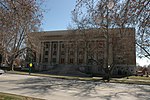The Avenues, Salt Lake City
All pages needing cleanupHistoric districts on the National Register of Historic Places in UtahNRHP infobox with nocatNational Register of Historic Places in Salt Lake CityNeighborhoods in Salt Lake City ... and 1 more
Wikipedia introduction cleanup from July 2020
The Avenues is an affluent neighborhood in Salt Lake City, Utah. It is named after the perfectly gridlike, closely laid out roads called Avenues (numbers, 1st - 18th) and Streets (letters, A - V). First surveyed in the 1850s, the Avenues became Salt Lake City's first neighborhood. Today, the Avenues neighborhood is generally considered younger, more progressive, and somewhat "artsy" when compared to other neighborhoods. Many young professionals choose to live there due to the culture and easy commute to downtown.. It is also one of the most important strongholds of the Utah Democratic Party.
Excerpt from the Wikipedia article The Avenues, Salt Lake City (License: CC BY-SA 3.0, Authors).The Avenues, Salt Lake City
5th Avenue, Salt Lake City
Geographical coordinates (GPS) Address Nearby Places Show on map
Geographical coordinates (GPS)
| Latitude | Longitude |
|---|---|
| N 40.775 ° | E -111.875 ° |
Address
5th Avenue 486
84103 Salt Lake City
Utah, United States
Open on Google Maps









